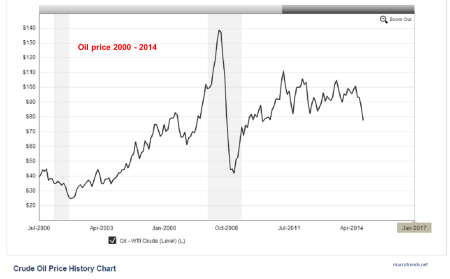The Royal Bank of Scotland is predicting a “cataclysmic” 2016 and advising its clients to “sell everything” except high quality bonds. Stocks will collapse by 10 – 20% and oil will drop to $16/barrel. As pessimism goes this is not just “Doom” it is “Painful and Imminent Doom”. The RBS team are clearly expecting an increasing panic feeding on itself, since there are “few exit doors”. Certainly their dire scenario will itself contribute to the darkening “mood”.
For the modest investor there are few “good” options. The task for them is not so much looking for upsides but one of limiting the downsides. It is probably best to just rely on the wisdom of the Godfather. Convert to cash and “go to the mattresses”.
RBS has advised clients to brace for a “cataclysmic year” and a global deflationary crisis, warning that major stock markets could fall by a fifth and oil may plummet to $16 a barrel.
The bank’s credit team said markets are flashing stress alerts akin to the turbulent months before the Lehman crisis in 2008. “Sell everything except high quality bonds. This is about return of capital, not return on capital. In a crowded hall, exit doors are small,” it said in a client note.
Andrew Roberts, the bank’s credit chief, said that global trade and loans are contracting, a nasty cocktail for corporate balance sheets and equity earnings. This is particularly ominous given that global debt ratios have reached record highs.
“China has set off a major correction and it is going to snowball. Equities and credit have become very dangerous, and we have hardly even begun to retrace the ‘Goldlocks love-in’ of the last two years,” he said.
Mr Roberts expects Wall Street and European stocks to fall by 10pc to 20pc, with even an deeper slide for the FTSE 100 given its high weighting of energy and commodities companies. “London is vulnerable to a negative shock. All these people who are ‘long’ oil and mining companies thinking that the dividends are safe are going to discover that they’re not at all safe,” he said. ….
Brent oil prices will continue to slide after breaking through a key technical level at $34.40, RBS claimed, with a “bear flag” and “Fibonacci” signals pointing to a floor of $16, a level last seen after the East Asia crisis in 1999. The bank said a paralysed OPEC seems incapable of responding to a deepening slowdown in Asia, now the swing region for global oil demand.
Morgan Stanley has also slashed its oil forecast, warning that Brent could fall to $20 if the US dollar keeps rising. It argued that oil is intensely leveraged to any move in the dollar and is now playing second fiddle to currency effects.
RBS forecast that yields on 10-year German Bunds would fall time to an all-time low of 0.16pc in a flight to safety, and may break zero as deflationary forces tighten their grip. The European Central Bank’s policy rate will fall to -0.7pc.
US Treasuries will fall to rock-bottom levels in sympathy, hammering hedge funds that have shorted US bonds in a very crowded “reflation trade”. ………..
Business Insider has the RBS bullet list of concerns which are giving their bleak view of 2016:
My bullet point themes into 2016 are (remain):
- Bearish China
- Bearish global commodities (hards, softs, fluids). And more specifically . . .
- Bearish oil (target $26, then clear risk of $16)
- CBs (mostly everywhere) will ease more
- The world has far too much debt to be able to grow well – global output
- gap widens
- Emerging market majors (outside India & Eastern Europe) all remain sells
- Automation on its way to destroy 30-50% of all jobs in developed world
- Currency war / mercantilism
And my new bullet point themes:
- Global disinflation risks turning into global deflation in 2016
- Everyone thinks ‘goldilocks’. We thought this strongly for >2 years (on our liquidity theme) but now worry about equities/credit, both huge, multi-year, well held positions. Negative returns in 2016 are probable, though without a recession they should be manageable, think -10-20%, rather than a rout
- If we see weaker ‘risk on’ products, the last safe ‘high yielder’ is the EMU periphery. Our new 0.75% 10y BTP target could prove too high a yield
- Risks to 0.16% new 10y bund target are on the downside, not upside
- Main risk comes from oil. A plunge sub $20 would aid consumption
It could be a bad year for the small investor.









